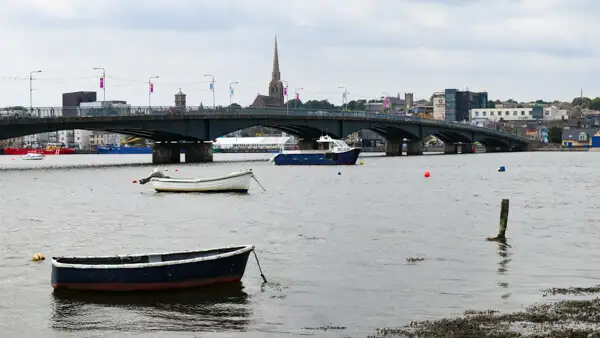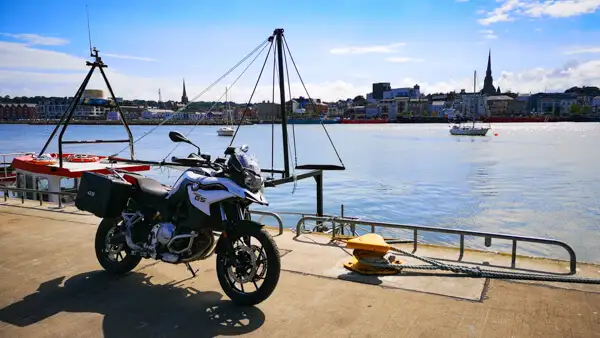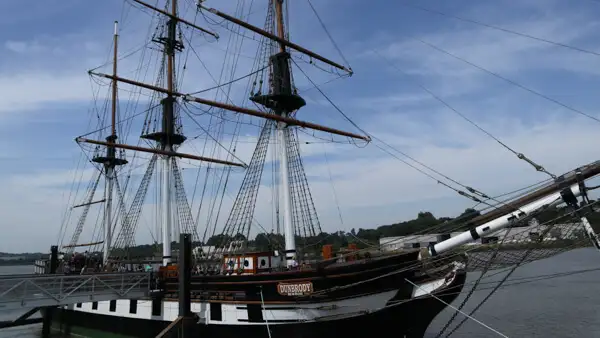So old, so new – the town of Wexford has given itself this subtitle and there’s no better way to put it: Wexford is a modern town with a long history and a very endearing charm….
Page Contents (click line to jump the text)

The history of Wexford
And again I start with the Vikings – because the city of Wexford was also founded by Vikings. This also applies to Waterford, Dublin, Limerick and Cork.
Wexford was founded around the year 800. The old Norwegian name of the town was “Waes-Fjord” in today’s spelling, because the old Norwegian characters are different. Waes-Fjord meant something like sandy bay or bay in the mudflats.
This describes the location very well, as the bay, which is formed by the mouth of the River Slaney, is very sandy and the tides create shifting sandbanks, which ensure that the harbour is practically only used as a fishing and pleasure boat harbour today. Much later, a deep-sea harbour was built at Rosslare, from which large ferries sail to England, France and Spain.
The Vikings had no problems with the Waes Fjord, quite the opposite. The sandy bottom meant it was safe to land because there were no dangerous cliffs. And shallow water with sandbanks was no obstacle for the shallow Viking ships.
As the Vikings found a natural harbour for their ships here in the sheltered bay, they established a base here, traded, settled permanently, built fortifications and eventually a proper town. Only a few of these remains have been found, as the Vikings were still building out of wood, which did not survive the test of time.
In the 12th century, the Anglo-Normans sailed over from England and began their invasion of Ireland. They also appreciated the good harbour and fortified the town – in their Norman style, with stone buildings and fortifications.
In the 18th century, the Irish Confederacy resisted British domination. The south-east of Ireland became a stronghold of resistance and this also affected Wexford. When Oliver Cromwell came over from England with an army and many cannons, his army fought the Irish resistance very successfully. The rebellious town of Wexford was plundered and reduced to rubble.
There were also Irish uprisings against British rule in the 18th century. And again, the south-east was involved on the front line. In 1798, the great decisive battle at Enniscorthy was lost by the Irish and the rebels in Wexford were also crushed. I have already written a separate article on Enniscorthy, which I will link to at the end of this article.

Wexford’s townscape today
If you are travelling to Wexford from the north (Dublin), you enter the town via a large bridge over the Slaney. From the bridge you have a beautiful view of the wide river, the bay, the harbour and the town beyond.
To the left of the bridge is the large jetty for the fishing boats and behind it a smaller marina. There you will find a large car park and the tourist information office. You can easily park here and explore Wexford on foot.
The town centre is located slightly above the harbour and Main Street is practically a pedestrian zone with small shops, cafés and restaurants.
The streets are narrow and there are many very small alleyways. This structure dates back to the time when this was a Viking town.
There is a colourful mix of older and newer buildings and I think “colourful” describes the cityscape as a whole quite well.

Places of interest in Wexford
Wexford also has some beautiful sights to offer:
National Opera House
The town of Wexford is very proud of its Opera House. Every year it hosts an opera festival that specialises in rare operas and is therefore internationally renowned. See: https://www.nationaloperahouse.ie/.
Irish National Heritage Park
I personally like the Heritage Park very much. It is located on the River Slaney and is an open-air museum with a very large wooded area. Here you will find the early to middle history of Wexford and Ireland reconstructed and explained: How did the first people live on the island, how did the Celts, the Vikings and the Normans? See: https://irishheritage.ie/.
Johnstown Castle
Johnstown Castle is located just outside the city centre, to the south of Wexford. It is a very beautiful castle with gardens and a lovely park and an agricultural museum. See: https://johnstowncastle.ie/.
Eating, drinking and staying overnight
There are several hotels, B&Bs and campsites in Wexford and the surrounding area. You can easily find pubs and restaurants in the old town. You can find more information about accommodation here: https://www.visitwexford.ie/directory-category/stay/.
Excursion destinations in the surrounding area
The surrounding area of Wexford also offers some beautiful destinations:
Curracloe Beach
If you follow the small coastal road northwards from Wexford, you will soon come to the small village of Curracloe. Look out for the signs to the beach and follow them. Curracloe Beach is a very large, long and wide sandy beach with high dunes. Climb up the dunes and enjoy the distant views – this beach is fantastic!
Several film directors have already found this to be the case and Curracloe Beach was featured in the film “Saving Private James Ryan” with Tom Hanks, as well as in the film “Brooklyn” with Saoirse Ronan.

Hook Lighthouse
The Hook Lighthouse is the oldest working lighthouse in the world. I’ve already written an article about it, which I’ll link to below. The lighthouse is beautiful, the location on the cliffs is fantastic and the Hook Peninsula is absolutely worth a day trip! See: https://hookheritage.ie/.
Wexford Wildfowl Reserve
To the north of Wexford is a partly marshy nature reserve where millions of migratory birds stop off and breed every year. If you’re a nature lover, you might want to check it out. See: https://www.wexfordwildfowlreserve.ie/.
Dunbrody Famine Ship
New Ross is only a short drive away and if you are on your way to Waterford, you will pass by. A beautiful three-masted sailing ship, the Dunbrody, is moored in New Ross harbour.
It is a replica of a freighter in which many Irish emigrated to the USA and Canada in the middle of the 19th century to escape the famine in Ireland (The Great Famine). The ship is a small museum and the guided tour is highly recommended! See: https://www.dunbrody.com/.
Conclusion
I know Wexford very well as we have been there many times. We live in the south-east (second home). Originally, I come from Germany.
I personally really like Wexford. It has a cosy, rural, Irish charm. The small old town is nice and I also like the harbour.
If you’re travelling in the south-east, Wexford is definitely worth a visit.
Have fun in Wexford!
More interesting articles for you
THE REBELLIOUS TOWN OF ENNISCORTHY
HOOK HEAD LIGHTHOUSE – THE OLDEST ACTIVE LIGHTHOUSE IN THE WORLD
THE AMAZING KILKENNY CASTLE
Picture credits cover picture: Wexford Harbour, photo by Ulrich Knüppel-Gertberg (www.irland-insider.de, www.ireland-insider.com)